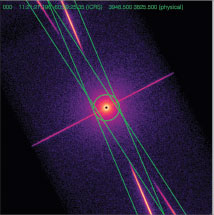 AstroNotes
AstroNotes
Editors
Shannon D. Willoughby, Montana State University, Bozeman, MT
Janelle M. Bailey, Temple University, Philadelphia, PA
Richard Gelderman, Western Kentucky University, Bowling Green, KY
2025
Time-traveling telescopes: An approach to teaching quantum entanglement In Special Collection: Quantum Topics in the Introductory Physics Classroom by Kater Murch
The Physics Teacher 63, 800–801 (2025) https://doi.org/10.1119/5.0305138
Quantum lessons: The discovery that stars are mostly hydrogen and helium
In Special Collection: Quantum Topics in the Introductory Physics Classroom by Megan Donahue
The Physics Teacher 63, 700–701 (2025) https://doi.org/10.1119/5.0304041
Mapping the galaxy with the hydrogen spin flip by Donald A. Smith.
The Physics Teacher 63, 606–607 (2025) https://doi.org/10.1119/5.0298484
Is quantum retrocausality of gravitationally lensed light from quasars real? by In Special Collection: Quantum Topics in the Introductory Physics Classroom James K. Freericks.
The Physics Teacher 63, 512–513 (2025) https://doi.org/10.1119/5.0282010
The quantum universe: How tiny fluctuations can shape cosmic evolution In Special Collection: Quantum Topics in the Introductory Physics Classroom by James Negus
The Physics Teacher
Quantum mechanics goes boom by In Special Collection: Quantum Topics in the Introductory Physics Classroom G. Mark Voit
The Physics Teacher 63, 292–293 (2025) https://doi.org/10.1119/5.0270248
Degeneracy pressure in stars and stellar corpses In Special Collection: Quantum Topics in the Introductory Physics Classroom
The Physics Teacher 63, 212–213 (2025) https://doi.org/10.1119/5.0260882
Quantum mechanics in the stars by Donald A. Smith
The Physics Teacher 63, 132–133 (2025) https://doi.org/10.1119/5.0253026
Astronomical connections to the International Year of Quantum Science and Technology: Embracing wonder while confronting overblown rumors of inexplicability by Richard Gelderman The Physics Teacher 63, 66–67 (2025) https://doi.org/10.1119/5.0248097
2024
Building and using solar wax melters by Judith Beck.
The Physics Teacher 62, 694–695 (2024) https://doi.org/10.1119/5.0238721
Analog environments by Michael C. LoPresto
The Physics Teacher 62, 614–615 (2024) https://doi.org/10.1119/5.0231838
Modeling the expansion of the universe by Katrina Brown; Cheryl Harper.
The Physics Teacher 62, 538–539 (2024) https://doi.org/10.1119/5.0232576
Long trips near the speed of light by Michael C. LoPresto
The Physics Teacher 62, 408–409 (2024) https://doi.org/10.1119/5.0210668
NASA PUNCH Outreach products celebrate diverse views of our sun, eclipsed or not by Cherilynn Morrow
The Physics Teacher 62, 232–233 (2024) https://doi.org/10.1119/5.0199427
Less content is more in introductory astronomy by Jennifer Delgado.
The Physics Teacher 62, 70–71 (2024) https://doi.org/10.1119/5.0180883
2023
A Fermi paradox survey by Michael C. LoPresto
The Physics Teacher 61, 808–809 (2023) https://doi.org/10.1119/5.0181028
Adopting a star improves student interest in astronomy by Anne Tabor-Morris
The Physics Teacher 61, 712–713 (2023) https://doi.org/10.1119/5.0177636
Fusion confusion and the language of astronomy by Janelle M. Bailey.
The Physics Teacher 61, 630–631 (2023); https://doi.org/10.1119/5.0173368
Explore the expanding universe with Rubin Observatory by Ardis Herrold; Edward Prather
The Physics Teacher 61, 536–537 (2023) https://doi.org/10.1119/5.0156703
Why every astronomy class should devote time to light pollution education
The Physics Teacher 61, 404 (2023) https://doi.org/10.1119/5.0149904
Stellar photometry in an introductory physics lab (or, translating flux into magnitudes)
The Physics Teacher 61, 310 (2023); https://doi.org/10.1119/5.0146515
Blind and visually impaired-accessible software and learning resources open a new window to the universe
The Physics Teacher 61, 230 (2023); https://doi.org/10.1119/5.0143252
An even more “harmonic” version of Kepler’s third law
The Physics Teacher 61, 150 (2023); https://doi.org/10.1119/5.0135264
Extending angles into the vastness of space
The Physics Teacher 61, 84 (2023); https://doi.org/10.1119/5.0134567
2022
Not quite like the movies: Teaching the realities of space exploration by Shannon D. Willoughby, Bahereh A. Samie, Janelle M. Bailey, Rebecca E. Vieyra and Ramon E. Lopez The Physics Teacher 60, 708 (2022); https://doi.org/10.1119/5.0120187
A tale of two bridges and a |round Earth The Physics Teacher 60, 614 (2022); https://doi.org/10.1119/10.0014307
Learning about the early history of astronomy through Phystory by Joanna Behrman The Physics Teacher 60, 524 (2022); https://doi.org/10.1119/5.0115743
Electronic telescopes and their use in astronomy education
The Physics Teacher 60, 394 (2022); https://doi.org/10.1119/10.0010401
NITARP, the NASA/IPAC Teacher Archive Research Program
The Physics Teacher 60, 312 (2022); https://doi.org/10.1119/10.0010004
Astronomy activities for promoting scientific evaluation
The Physics Teacher 60, 230 (2022); https://doi.org/10.1119/10.0009695
Apparent retrograde motions of planets
The Physics Teacher 60, 150 (2022); https://doi.org/10.1119/10.0009427/p>
Real astronomy data for anyone: Explore NASA’s IRSA
The Physics Teacher 60, 72 (2022); https://doi.org/10.1119/10.0009117
2021
Robotic telescope labs for survey-level undergraduates
The Physics Teacher 59, 728 (2021); https://doi.org/10.1119/10.0007416
Machine learning in introductory astrophysics laboratory activities
The Physics Teacher 59, 662 (2021); https://doi.org/10.1119/10.0006925
Lunar astrometry
The Physics Teacher 59, 590 (2021); https://doi.org/10.1119/10.0006471
Better interactive astronomy lectures using the Laser-Assisted Student Engagement Routine
The Physics Teacher 59, 502 (2021); https://doi.org/10.1119/10.0006144
2020
JS9: An interactive tool for teaching astrophysics
The Physics Teacher 58, 602 (2020); https://doi.org/10.1119/10.0002391
Expanding minds through explorations of our expanding universe
The Physics Teacher 58, 520 (2020); https://doi.org/10.1119/10.0002079
We’d like to know how we’re doing and where we’re going!
The Physics Teacher 58, 442 (2020); https://doi.org/10.1119/10.0001850

